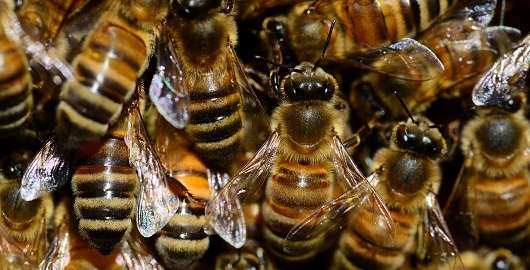New research debunks honey bee pesticide study

A study by a global agrochemical company that concluded there was only a low risk to honey bees from a widely used agricultural pesticide has been described as "misleading" in new research published by statisticians at the University of St Andrews.
Pesticides called neonicotinoids or neonics may be implicated in losses of honey bees and other pollinators. The economic value of honey bees and bumble bees on the pollination of commercially grown crops has been estimated at over £200 million a year in the UK alone.
A major study conducted by Swiss agrochemical company Syngenta on the effects of the neonic thiamethoxam on honey bees in the field concluded that there was only a low risk to honey bees.
New research conducted at the Centre for Research into Ecological and Environmental Modelling (CREEM) by Dr Robert Schick, Professor Jeremy Greenwood and Professor Steve Buckland shows even large and important effects could have been missed because the Syngenta study was statistically too small.
Their findings are published today in the international journal Environmental Sciences Europe.
The Syngenta study involved two experiments: an oilseed rape experiment conducted at two locations and a maize experiment at three locations. At each location the experiments used pairs of fields – in one field the crop was treated with thiamethoxam at levels normally used by farmers, in the other field the crop was untreated.
The Syngenta study concluded that because the experiments involved so little replication (two cases for oilseed rape and three for maize) a formal analysis of the data "would lack the power to detect anything other than very large treatment effects, and it is clear from a simple inspection of the results that no large treatment effects were present. Therefore a formal statistical analysis was not conducted because this would be potentially misleading".
The St Andrews team believe this is fundamentally wrong because formal statistical analysis is only potentially misleading if the wrong method is used and because the mere inspection of the results is always potentially misleading because it is an entirely subjective procedure.
Professor Greenwood said: "In order to reach valid conclusions about the results of an experiment such as this, one needs not just to estimate the effect of the treatment but also to measure the precision of the estimate. That is what we have done, using standard statistical techniques.
"What we found was that the estimates of the treatment effects were so imprecise that one could not tell whether the effects were either too small to pose a problem or, in contrast, so large as to be of serious concern.
"In effect, the experiments were on such a small scale that little useful could be concluded from them."
More information: An experiment of the impact of a neonicotinoid pesticide on honey bees; the value of a formal analysis of the data. https://risweb.st-andrews.ac.uk/portal/en/researchoutput/an-experiment-of-the-impact-of-a-neonicotinoid-pesticide-on-honey-bees-the-value-of-a-formal-analysis-of-the-data(e8f778c3-f847-46f3-8a29-5e7bbdb2c219).html
Provided by University of St Andrews
















